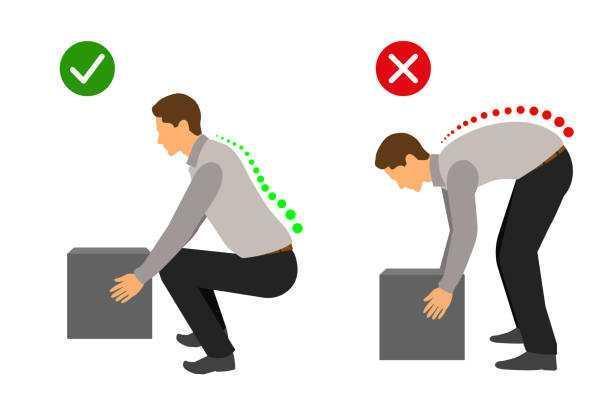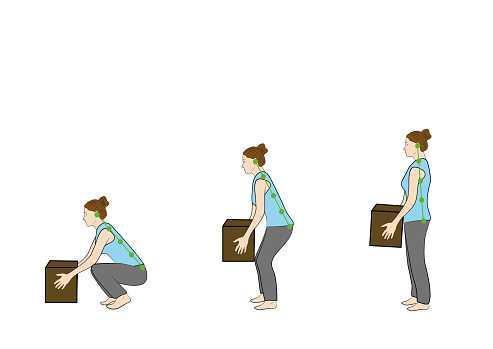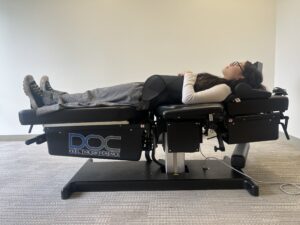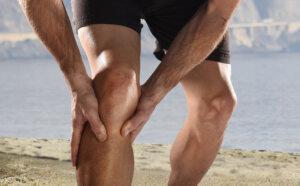Many people injure their backs while bending or lifting objects in the wrong way. A recent survey taken by the American Physical Therapy Association reports that nearly two-thirds of the Americans experience low back pain, and nearly half of the cases are due to improper bending and lifting techniques.
As we get older, we are more likely to hurt our back while bending or lifting to put something up or down. The reason to this is that as we get age our muscles and ligaments became less flexible; also, past injuries of the muscles, ligaments or spinal disks make us more prone to having a back injury. Along with back pain, improper lifting technique can lead to arm pain and leg pain, and can cause acute injury with serious long-term effects.
The good thing about this is that these injuries are avoidable. All you need to do is learn and practice proper lifting and bending techniques.
The sad thing is that most people are aware of this, but rarely perform these techniques. They are ready to risk injury, instead taking the time to perform lifting activities properly.
According to this, the importance of safe lifting techniques cannot be understated, so we decided that it’s time to talk little about how to avoid these injuries.
So, here you will find few essential tips to help you protect your spine from painful and unnecessary injuries.
What Is Safe Lifting and Bending?
Often, safe lifting emphasizes protecting the back. But the approach is more comprehensive and includes several main focuses.
First and foremost, you should be aware of your lifting limit, and try to stay within it. In order to prevent injury, don’t lift items that are too heavy for you.
The next crucial component is protecting the back, or more precisely, protecting the joints of the spine. Proper lifting techniques and strategies come into play here in order to decrease the risk of injury.
And lastly, consider the strength, mobility, and position of the knees and feet. Depending on the size and weight of the item you are lifting, foot placement, knee and hip alignment should be taken into consideration.
How Heavy Is Too Heavy?

It is important to know how much you can safely lift. No one can give you a precise weight of how much you can lift, but think about how much you have lifted in the past and how easy or hard that was and you’ll have your answer.
And although weight has big impact on the risk for a back injury, alone is not that much dangerous. Even if you don’t lift heavy objects, you can still get an injury. If you are not careful, you can strain your back even when lifting something as light as a pen.
According to the Center for Construction Research and Training, other factors that determine the risk, include:
- How often you’re lifting something
- Bending and twisting while lifting
- Whether you hold an object away from you while lifting
- How high you’re lifting an object
- How long you lift or hold the object
When talking about heavy lifting, it is important to note that back belts do not decrease the risk of injury. It is common for many people to wear back belts or a back support when lifting, but according to the researches, back belts do not decrease the risk of a lifting injury. And because of this, they are not recommended. So, instead of relying on a back belt, next time try to use good lifting technique and only lift objects that aren’t heavier than you would lift without a belt.
DOs and DON’Ts – Tips For Proper Lifting and Bending Techniques

DO’s :
- You should keep your feet apart to give your body a wide base of support
- You could stand as close as possible to the object you are lifting
- You may try to hold the object as close as possible to your body
- Try bending at your knees, not at your waist or back
- Slowly lift, using your muscles in your hips and knees
- Keep your shoulders in line with the hips
- To change direction move the hips and shoulders in unison
- Tighten your stomach muscles as you lift the object up or lower it down
- Squat as you set the object down, using the muscles in your knees and hips, keeping your back straight
- Always use both your hands
DON’Ts :
- Do not bend at your waist, instead squat – using the muscles in your knees and hips
- Do not bend forward, as you stand up with the object,
- Do not twist your back while you bend to reach the object, lift the object, or carry the object
- Avoid rapid twisting of the spine
- Do not hold your breath while you lift an object. Exhaling out is the proper technique to use.
- Do not use a partial grip on an object
- Do not obstruct your vision with the object you are carrying.
Correct Lifting Position and Technique

In order to properly perform lifting and bending techniques try following these steps:
- Plan ahead before lifting – Knowing what you’re doing and where you’re going will prevent you from making awkward movements while holding something heavy.
- Lift close to your body – You will be more stable lifter if you hold the object as close to your body as possible.
- Feet should be shoulder-width apart – Keeping your feet shoulder-width apart and taking short steps will provide you with a solid base of support, which is very important while lifting.
- Bend your knees and hips and keep your back straight – Raise and lower to the ground by bending your knees rather than bending at the waist or hips.
- Tighten your stomach muscles – Tightening your abdominal muscles will help you hold your back straight and will prevent putting excessive force on the spine.
- Lift with your legs – this is one of the most important points, don’t forget it.
- Looking slightly upwards – This will help you maintain a better position of the spine and help you keep your back straight.
- Don’t twist or bend – It is important to turn your body as whole, so if you need to change direction don’t twist. Stop, turn in small steps, and then continue walking.
- If the object is too heavy get help
To find out if you are a victim to improper lifting and bending and get to the root cause of pain and discomfort, schedule an initial consultation, including a comprehensive evaluation and first treatment.



